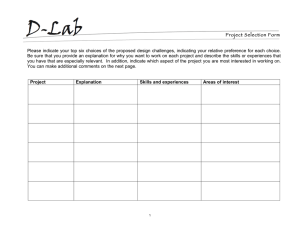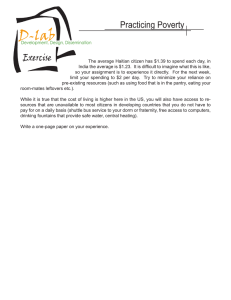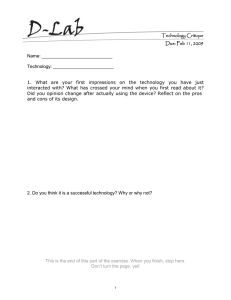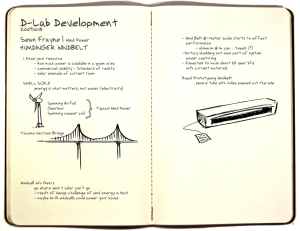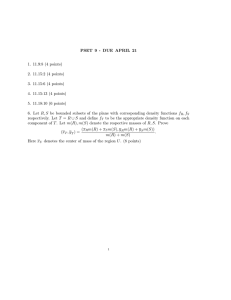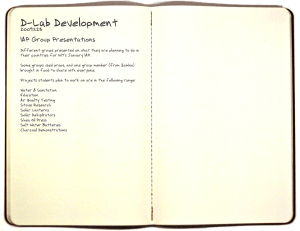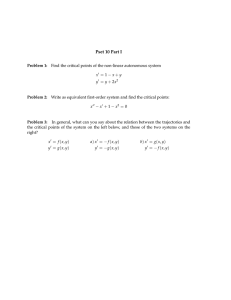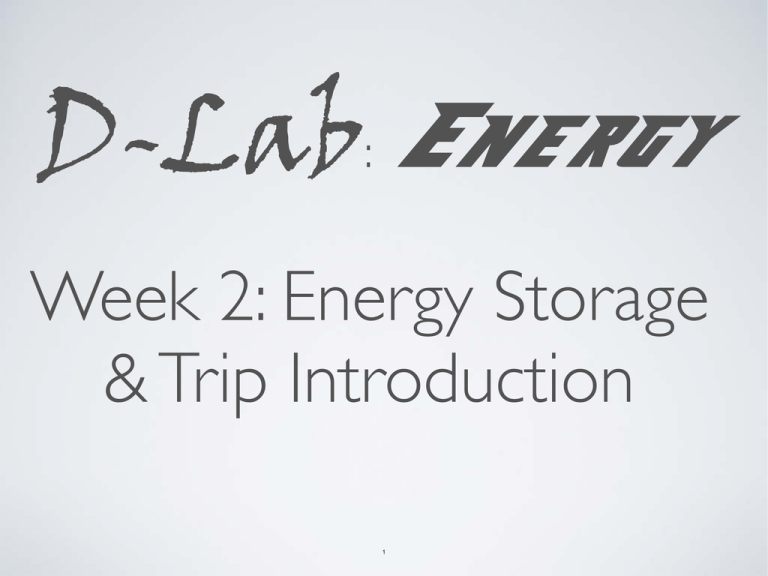
D-Lab: Energy
Week 2: Energy Storage
& Trip Introduction
1
AGENDA
Where are we?
• Muddy Card Review
• Human Power Review
• Energy Storage & Micro Grids
•
Trip Plan
• Reading discussion
• Homework
• Muddy Card
•
2
3
Muddy Cards!
4
LANTERNS
5
Photos removed due to copyright restrictions.
See lecture video.
WATER: TUMP LINE / NAMLO
6
Photo removed due to copyright restrictions.
See lecture video.
HEAD CARRY
(GETTING HELP LOADING / UNLOADING IS
NORMAL)
7
Pedal Power in Transportation
Several slides removed due to copyright restrictions.
See lecture video.
8
Pedal Power in Work: Pedal-Powered Machines
Several slides removed due to copyright restrictions.
See lecture video.
9
THE PROBLEM WITH POWER
10
POWER GRIDS
&
ENERGY STORAGE
11
Images removed due to copyright restrictions.
"Visualizing the U.S. Electic Grid." NPR. May 1, 2009.
See lecture video for discussion of this content.
http://www.npr.org/templates/story/story.php?
storyId=110997398
12
JUMPER CABLE SCENARIO
• 400 Amps
• 12 V
• AWG
26: 0.01594” diameter
• AWG
4: 0.20431” diameter
• copper
• what
resistivity: 1.724x10^-8 ohm-m @ 20 deg. C
length cable can be used for each AWG?
13
MICROGRIDS
Benefits
Challenges
• autonomy
• maintenance
• compatibility
• limiting
loads
• flexibility
• private
vs. public sector
• scalability
14
Courtesy of Prof. Cutler J. Cleveland. Used with permission.
15
© ICCNexergy. All rights reserved. This content is excluded from our Creative Commons license. For more information, see http://ocw.mit.edu/fairuse.
16
EXCELLENT BATTERY
RESOURCE
http://web.mit.edu/2.009/www/resources/mediaAndArticles/
batteriesPrimer.pdf
17
BATTERY CONSIDERATIONS
• Physical
characteristics: size, shape weight
• Voltage: nominal, maximum, minimum, discharge profile
• Load current: rate, constant power, constant resistance, pulsed
• Duty cycle: continuous, intermittent, cyclic
• Charge/discharge cycle: cycling (float), deep cycle, efficiency of
charging
• Temperature range: maximum, minimum and nominal
• Service life: required operation time
• Safety: failure rates, leakage, off-gassing, toxicity, disposal
• Environment: vibration, acceleration, orientation
• Maintenance: regular upkeep, replacement
(c) David Wallace, http://web.mit.edu/2.009/www/
• Cost: initial, life-cycle
resources/mediaAndArticles/batteriesPrimer.pdf
18
SIZING BATTERIES
1. Determine energy source daily
average, as well as daily and seasonal
variation
2. Determine load daily average, as well as
daily and seasonal variation
3. Required days of storage (autonomy)
3.1. typically 3-6 days, depending on
daily and seasonal source & load &
variation
DC Energy Source
Charge Controller
98% efficient
Battery
(never below 20%)
Inverter (DC to AC)
75% efficient
Load (AC)
4. Iterate given budget
19
ESTIMATIONS
1. Power for typical objects
i.
Light
ii.
Tv
iii.
Computer
iv.
Car
v.
Motorcycle
vi.
Fridge
vii.
Oven
viii.
Radio
2. personal daily energy consumption (turn in)
20
D-Lab: Energy
Public domain image (source: US CIA).
Next Lab: Energy Storage
Next Class: Lighting (& community
partner intro.)
21
SPRING BREAK TRIP
• Spring
• Cost
• DO
• fill
break: March 19-26 (approximate)
for you: $500 + medical, passport/visa, food, & gifts
NOW
out form online (posted tonight or tomorrow)
• check
passport expiration & visa requirements
• make
MIT Medical travel clinic appointment for vaccines
• be
prepared to commit to trip/class on Friday
• review
packing list (posted tonight or tomorrow)
22
ENERGY READING
DISCUSSION
Practical Action. Poor People's Energy Outlook 2010.
http://practicalaction.org/ppeo2010
23
PSET 2: PERSONAL ENERGY
CONSUMPTION CHALLENGE
Determine your total energy used on a given day and average power
consumption.
Choose two days over the following week.
Day 1: consider only consumables (you do not need to worry about the energy required to make
the laptop, etc., just the energy you consumed using it), document the energy you used.
Possibilities: food, cooking, water, lighting, electricity for laptops/computer/cellphone/other appliances
and technology, heating/cooling, transportation). You’ll need to do a lot of estimating here; that’s to be expected, just document how you arrive at
your numbers. For a shared situation (for example, taking a public bus with 10 other people), you
can divide to calculate your portion.
Estimate/calculate the total energy consumed by your life (daily), and calculate your average power
usage.
What percentage of your daily energy consumption is in your control? What is out of your control
(for example, in most dorms and classrooms you have NO control over the temperature)? What
is a grey area (for example, you can choose which computing device to use to do your work, but
you can’t eliminate use of a computer entirely if you want to pass your classes)?
24
PSET 2: PERSONAL ENERGY
CONSUMPTION CHALLENGE
Day 2:
Make a list of the areas where you think you can cut back, and by how much. Strive to cut
back aggressively ... cutting back by 1% is not sufficient.
Implement your cutbacks for one day and calculate how close you were to your estimate in
part a.
Write about the experience: how hard was it to cut back? Discuss how close you were to
your target and if you were off, how and why. Where else would you have liked to cut back
but couldn’t, and why not? Other reflections on the experience.
If you were forced to use 10% of the energy you currently estimate you’re using, what
would you do? Where does that 10% goal come from? You may recall from week 1 that in
the US our average annual energy usage per capita is 360 GJ, whereas in Nicaragua it’s 25
and in Haiti it’s 11.
OTHER: plastic bottles & Spanish podcasts
25
MIT OpenCourseWare
http://ocw.mit.edu
EC.711 D-Lab:
Energy Spring 2011
For information about citing these materials or our Terms of Use, visit: http://ocw.mit.edu/terms.

